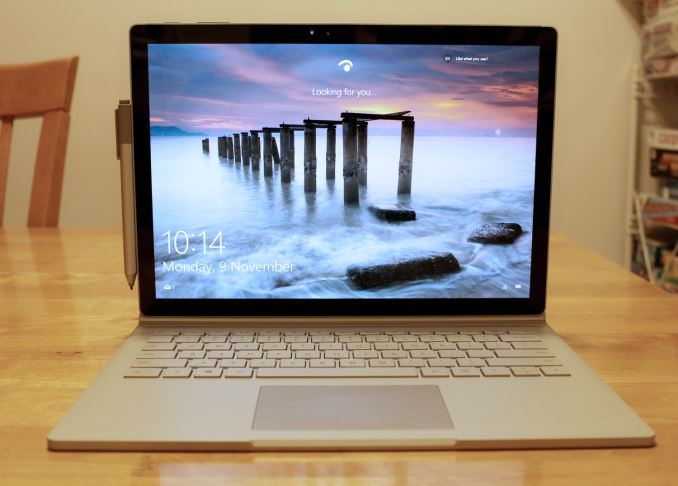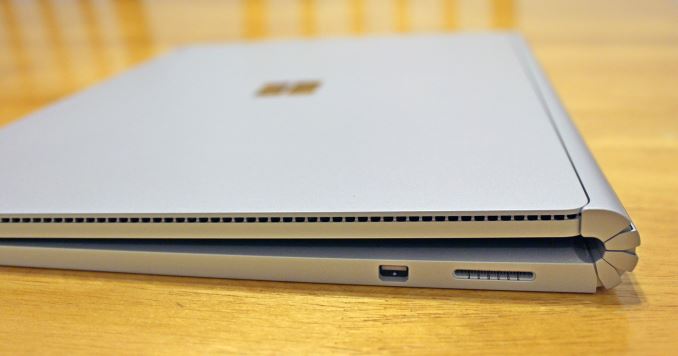The Microsoft Surface Book Review
by Brett Howse on November 10, 2015 8:00 AM EST
When Microsoft first launched the Surface Pro, they decided to tackle a market that was pretty much untested. Sure, tablets had been around for a while already, but no one had packed a full Ultrabook inside of a tablet. True, the initial Surface Pro had some compromises made due to the hardware available at the time, but Microsoft started to build a brand with Surface, a brand that they lifted from another product line altogether. It’s taken a few generations for the hardware to catch up with that original vision, but I think it’s fair to say that the Surface Pro tablet line has solidified itself as the Windows tablet to beat. The build quality, materials, and performance, are really second to none at this time.
I’m talking about branding because it’s one of the most difficult parts of a new product lineup. Microsoft, perhaps more than most companies, has certainly had its struggles with branding over the years. Surface though, has truly been defined, and molded, and evolved, into a strong brand for the company, and it plays right at the high end. And that brings us to Surface Book. Surface Book is an extension of the Surface brand, and Microsoft now wants to try its hands at the laptop market. Their goals for Surface Book are certainly not the same as they were for the original Surface Pro, since the laptop market is already well defined, and there are already many excellent devices available. For Microsoft to throw their hat in the ring in this segment is a much different proposition than before, and to succeed, as well as to continue to evolve the Surface brand, they set out to build what they are calling “The Ultimate Laptop”.
Surface Book certainly keeps the tradition of Surface alive and well. The 13.5-inch laptop has the same 3:2 aspect ratio of the rest of the Surface line, and it is built out of magnesium with the same finish. The fit and finish is very high, and the entire device feels as premium as it should. I think the defining feature of the Surface tablet lineup is the kickstand, and with the Surface Book it is most certainly the hinge. The hinge on the Surface Book is truly unlike anything ever used on a notebook computer before, and while it may not be to everyone’s taste, it certainly draws comments. The hinge, other than a design element, brings a lot of function to the party as well, with it being a key component to keeping this laptop balanced correctly. Balance is generally not an issue with laptops, but the Surface Book has another trick up its sleeve – the display detaches. The Surface Book is hardly the first device to do this, but it is one of the few that has tried to tackle the balance problem with 2-in-1 devices where the screen detaches, and the hinge is a key component to that. Microsoft calls it a Dynamic Fulcrum Hinge, and it extends the base of the laptop slightly to give it more leverage over the display section.
The design is unique, and what is inside is unique as well, at least potentially. There are two models of the Surface Book. The first model is a typical Ultrabook inside, with an Intel Core i5-6300U processor, but the second model is the only detachable laptop which also has a discrete GPU. There are a couple of reasons this has never been done before, with the main reason being it’s very difficult to dissipate the extra heat that a GPU brings to the table. Microsoft has designed the Surface Book with a GPU which lives in the keyboard base, with the rest of the required components behind the display. This gives them two thermal zones, and by moving the GPU to the base like this, it lets the Surface Book cool the CPU and GPU independently. The extra space in the keyboard is then packed with batteries.
| Surface Book | |||
| Core i5 | Core i5 w/GPU | Core i7 w/GPU | |
| GPU | Intel HD 520 | Intel + "NVIDIA GeForce" (Approx. GT 940M) w/1GB GDDR5 |
|
| CPU | 6th Generation Intel Core i5-6300U (15w) | 6th Generation Intel Core i7-6600U (15w) | |
| Memory | 8-16GB RAM | ||
| Display | 13.5" IPS 3000x2000 resolution 1800:1 Contrast Ratio 100% sRGB, individually calibrated 10 point touch and Pen support |
||
| Storage | PCIe 3.0 SSD 128 GB to 1 TB | ||
| I/O | USB 3.0 x 2 (In Base) SD Card reader (In Base) Surface Connector (In Tablet and Base) Headset Jack Mini DisplayPort |
||
| Dimensions | Laptop (mm) : 232 x 312 x 13.0-22.8 (inches) : 9.14 x 12.3 x 0.51-0.90 Tablet Only (mm) : 220.2 x 312.3 x 7.7 (inches) : 8.67 x 12.3 x 0.30 |
||
| Weight | Laptop 1.515 kg / 3.34 lbs Tablet Only 726 g / 1.6 lbs |
Laptop 1.579 kg / 3.48 lbs Tablet Only 726 g / 1.6 lbs |
|
| Camera | Windows Hello (Front) 8 MP Rear Facing 5 MP Front Facing |
||
| Price | $1499+ | $1899+ | $2099+ |
Looking at the specifications, one thing to point out is the battery capacity. Most Ultrabooks would average somewhere around 50 Wh of capacity, with a few somewhat higher and a few somewhat lower. By combining the battery in the tablet, which Microsoft calls the Clipboard, with the base, the Surface Book has an amazing 70 Wh of battery capacity. This should help out on battery life, assuming the 3000x2000 display doesn’t drag that down. The rest of the Surface Book is pretty similar to the Surface Pro 4, with PCIe NVMe storage options up to 1 TB, and touch and pen support via the PixelSense display. There are also two USB 3.0 ports in the base, along with a DisplayPort output, and the Surface Connect port which is used for charging, as well as connecting the Surface Dock. There are no ports on the Clipboard at all, with the exception of the Surface Connect port, so if you are using the Clipboard on its own, you will have to dock it to access USB. Like the Surface Pro 4, it would have been nice to see a USB Type-C port included, and the Clipboard would be a perfect spot for that.
Microsoft is calling the Surface Book “The Ultimate Laptop” and that is a pretty lofty goal for a first generation product. In this review, we will examine all aspects of the Surface Book and see how they compare to the best laptops around. Let’s start with the design.











249 Comments
View All Comments
s.yu - Sunday, November 15, 2015 - link
I can double that, though I personally never saw the need for one and it was a gift of my father to my mother.Manch - Tuesday, November 10, 2015 - link
If you think 1.6lbs is too heavy you need to stop with the 40oz curls...Stuka87 - Tuesday, November 10, 2015 - link
Its not that I am unable to lift it...Its that trying to hold it in one hand casually while reading or surfing the web is simply not comfortable. Neither was the first gen iPad. It wasn't until the iPad Mini or iPad Air that Apple had a tablet that was light enough for this (There were of course other tablets before Apple that were fine)
s.yu - Sunday, November 15, 2015 - link
You know people like to lie flat on their beds while holding a tablet to watch a movie? 1.6lbs could give you a black eye if it slips. And magnesium is slippery.Manch - Tuesday, November 10, 2015 - link
IPAD PRO also 1.6lbs...solipsism - Tuesday, November 10, 2015 - link
But how long do those 1.6lb "tablets" last on a single charge? Can you even charge the Surface Book's tablet section independent of the base? MS really let their customers down with their poor logic board design.samsp99 - Tuesday, November 10, 2015 - link
Yes, you can charge the tablet without the base. It uses the same connector to connect to the base as the base uses to the power brick or dock. You can even use the dock directly with the tablet section.Manch - Tuesday, November 10, 2015 - link
yes you can charge it separately.nikon133 - Tuesday, November 10, 2015 - link
I think that they are really trying to differentiate Surface Book from Surface Pro tablet. Since both run desktop software and are fully compatible, differentiation is harder than between MB and iPad. I think that they have done it as good as it is possible, within given parameters. Surface Pro is primarily a tablet that can replace laptop, but if you need machine with physical keyboard all or most of the time, it is not the best solution. At least this is my conclusion after using Pro 3 half a year now, give or take. It is great without keyboard - I'm finding kickstand a real game-changer for any sort of lazy media consumption, browsing... and those few times a year when I need a laptop to do some work (usually when I travel and am away from my home desktop and my work laptop), it can deliver. But if I'd need laptop all the time, it would not be right product for me. This is where Book comes in. It is primarily laptop that can replace tablet - short turn. Should be good convergence device that is real laptop but gives owner much lighter tablet experience once in a while, or for short bursts. It also offers middle-ground with closed screen turned outwards, which looks fine for those who need tablet mode on the desk or lap (or any other scenario that does not require holding device in hand), with benefit of larger screen, dGPU and battery life better than Surface Pro can provide.I'm finding this differentiation (in specialization) less intrusive than, say, MacBook... where Air is kept with low resolution screens and chunky screen borders to reduce Air's impact on MBP and, recently, MB segment as well. In all the honesty, I think this task is harder for Apple, since they keep traditional laptop format which even further reduces their options.
NetMage - Monday, November 16, 2015 - link
You think 264ppi is low resolution?Also, there are sound ergonomic reasons for the thick bezels.